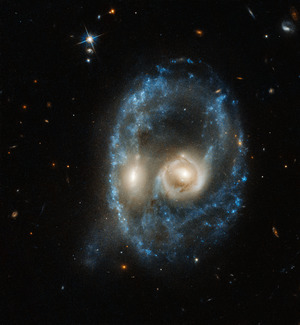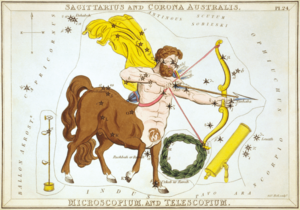Microscopium facts for kids
| Constellation | |

List of stars in Microscopium
|
|
| Abbreviation | Mic |
|---|---|
| Genitive | Microscopii |
| Pronunciation | /ˌmaɪkrəˈs[unsupported input]piəm/, genitive /ˌmaɪkrəˈs[unsupported input]piaɪ/ |
| Symbolism | the Microscope |
| Right ascension | 21h |
| Declination | −36° |
| Quadrant | SQ4 |
| Area | 210 sq. deg. (66th) |
| Main stars | 5 |
| Bayer/Flamsteed stars |
13 |
| Stars with planets | 2 |
| Stars brighter than 3.00m | 0 |
| Stars within 10.00 pc (32.62 ly) | 2 |
| Brightest star | γ Mic (4.67m) |
| Messier objects | 0 |
| Meteor showers | Microscopids |
| Bordering constellations |
|
| Visible at latitudes between +45° and −90°. Best visible at 21:00 (9 p.m.) during the month of September. |
|
Microscopium (pronounced my-kruh-SKOH-pee-um) is a small constellation in the southern part of the sky. Its name means "the Microscope" in Latin. It is one of twelve constellations created in the 1700s by a French astronomer named Nicolas-Louis de Lacaille. He named many of his new constellations after scientific tools.
Microscopium's stars are quite dim. This makes them hard to see without a telescope, especially from places far north of the equator. The brightest star in Microscopium is Gamma Microscopii. It is a yellow giant star located about 223 light-years away. Millions of years ago, this star might have passed very close to our own Solar System.
Scientists have found planets orbiting two stars in Microscopium: WASP-7 and HD 205739. Other stars, like AU Microscopii and HD 202628, have debris disks around them. These disks are made of dust and rock, and they can be places where new planets might form.
Contents
What is Microscopium Like?
Microscopium is a small constellation. It is surrounded by other constellations like Capricornus to the north and Sagittarius to the west. The International Astronomical Union (IAU) uses "Mic" as the short name for Microscopium.
The constellation's official borders were set in 1930. You can see the entire constellation if you are south of 45°N latitude. Because its stars are not very bright, it's hard to see Microscopium in cities where there is a lot of light pollution.
Stars in Microscopium
There are 43 stars in Microscopium that are bright enough to be seen with binoculars or a small telescope.
Brightest Stars
- Gamma Microscopii is the brightest star in the constellation. It is a yellow giant star that is about ten times bigger than our Sun. It is about 223 light-years from Earth. About 3.9 million years ago, this star might have come very close to our Sun. It could have even affected the distant Oort cloud around our Solar System.
- Alpha Microscopii is another aging yellow giant star. It is about 400 light-years away and is 17.5 times wider than the Sun. It has a dimmer companion star that can be seen with a small telescope.
- Epsilon Microscopii is a white star located 166 light-years away.
- Theta1 and Theta2 Microscopii are two stars that look like a wide double star. You can even see them as two separate points of light without a telescope.
Interesting Stars to Explore
Many stars in Microscopium are too dim to see without special equipment.
- Lacaille 8760 (also called AX Microscopii) is a red dwarf star. It is very close to our Solar System, only 12.9 light-years away. It is the brightest red dwarf star you can see in the sky.
- BO Microscopii is a very fast-spinning star. It is nicknamed "Speedy Mic" because it rotates completely in just over 9 hours. This star is very active and has huge flares that are much stronger than the Sun's flares.
- AU Microscopii is a young star with a debris disk around it. This disk is made of dust and rocks, and it might be a place where planets are forming. AU Microscopii is part of a group of stars called the Beta Pictoris moving group. These stars are moving together through space.
- DD Microscopii is a special star system called a symbiotic star. It has a large orange giant star and a small white dwarf star orbiting each other very closely.
Stars with Planets
- HD 205739 is a star similar to our Sun. It has a planet about the size of Jupiter orbiting it.
- WASP-7 is another star with a planet. This planet, called WASP-7b, is a "hot Jupiter". This means it's a gas giant like Jupiter but orbits very close to its star, making it very hot.
Deep Sky Objects
While Microscopium doesn't have many bright objects for amateur astronomers, it does have some interesting things far away in space.
- NGC 6925 is a barred spiral galaxy. It looks like a lens because we see it almost edge-on from Earth. A Type II Supernova (a huge star explosion) was seen in this galaxy in 2011.
- The Microscopium Void is a large, mostly empty area of space. It has very few galaxies.
- The Microscopium Supercluster is a huge group of many galaxy clusters.
Meteor Showers
The Microscopids are a minor meteor shower. You can sometimes see these meteors from late June to mid-July.
History of Microscopium
The constellation Microscopium was created by French astronomer Nicolas-Louis de Lacaille. He spent two years observing stars from the Cape of Good Hope in Africa. During this time (1751–1752), he named 14 new constellations in the southern sky. These areas of the sky could not be seen from Europe. Lacaille named most of his new constellations after scientific tools, celebrating the Age of Enlightenment. He first called it le Microscope in French, and later changed it to the Latin name Microscopium in 1763.
See also
 In Spanish: Microscopium para niños
In Spanish: Microscopium para niños
- Microscopium (Chinese astronomy)




